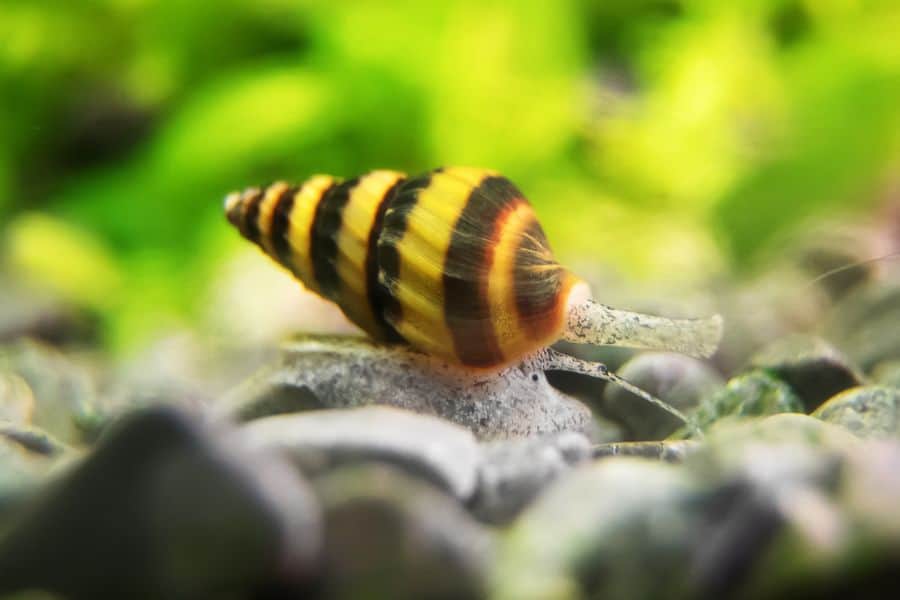Done right, a betta tank is a beautiful piece of living decoration that is sure to light up any room. But in our mind, looking at your solitary betta in his pretty aquarium sure does seem lonely. Maybe he’d like some company?
Bettas don’t mind being alone, but it’s still a great idea to add a companion creature in your betta aquarium – creatures such as snails.
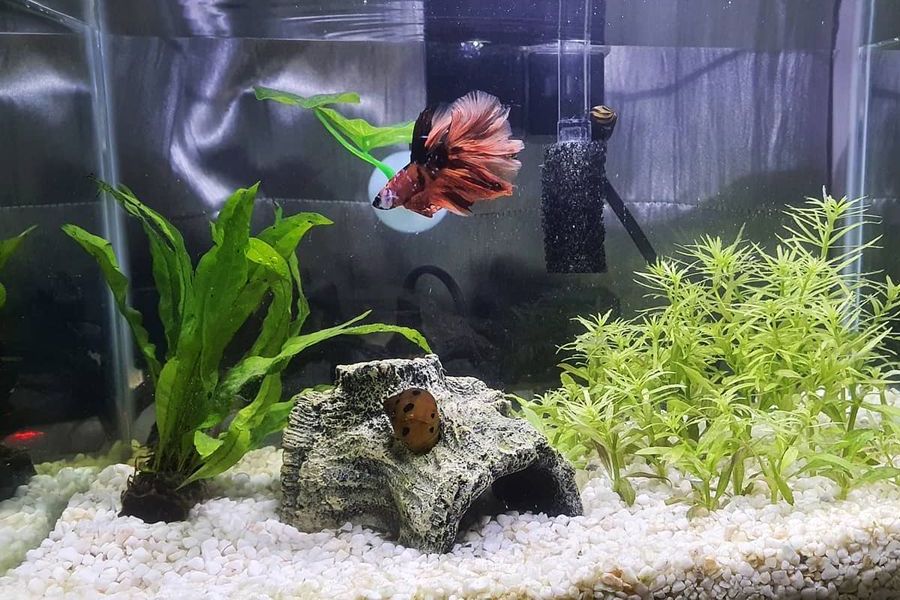
Snails are interesting creatures, intriguing in their own slow ways. They provide some benefits, too, which we’ll get into. But before you start adding snails to your tank, there are a few things you need to consider.
That’s what we’re going to tackle in this aquarium.
Can Snails Live With Betta Fish?
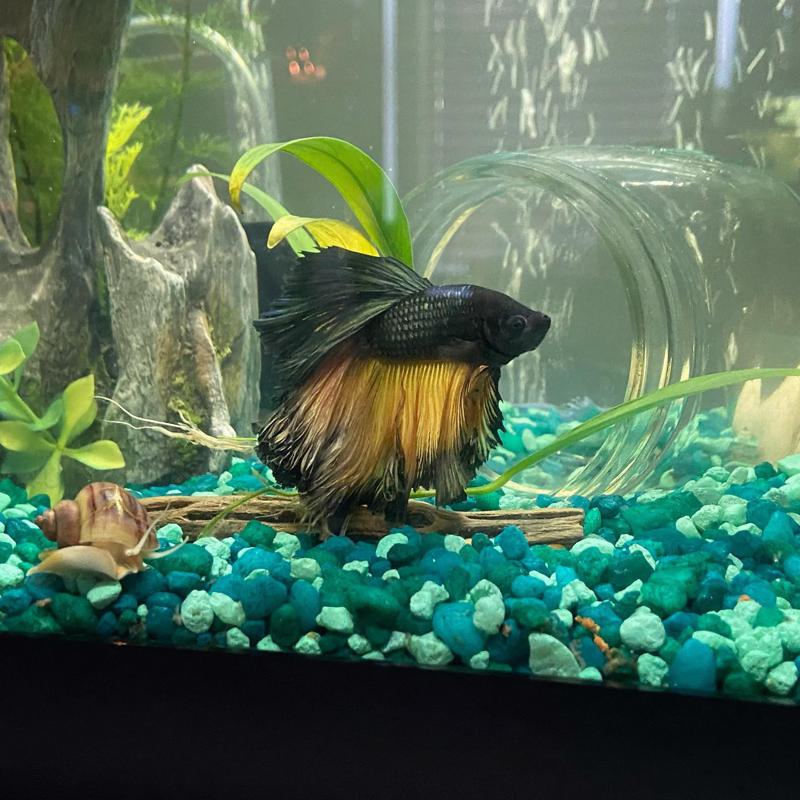
Yes, bettas and snails can live in one aquarium. In fact, adding snails into a betta aquarium is even a good idea most of the time. Both snails and bettas can coexist in the same water parameters, and snails are hardy and peaceful creatures, so they won’t threaten the betta.
However, there are still some considerations when adding snails to betta fish.
For example, bettas are territorial and can be aggressive with anything that it thinks is invading their territory. This can sometimes include snails, although that depends on the temperament of the specific betta.
Plus, you should also consider that bettas are natural hunters, and will most likely try to eat your snail as well.
While most snails are tough (especially adults), a particularly determined betta can still harass a timid snail to the point of death. Therefore, it’s important to provide plenty of hiding spaces that snails can use to keep themselves in sight.
Nevertheless, aside from those considerations, snails and siamese fighting fish is a tried-and-true pairing that has worked well for countless aquariums.
This kind of aquarium setup can even provide benefits for your betta, which we’ll talk about in the next section.
Benefits of Having Snails With Betta Fish
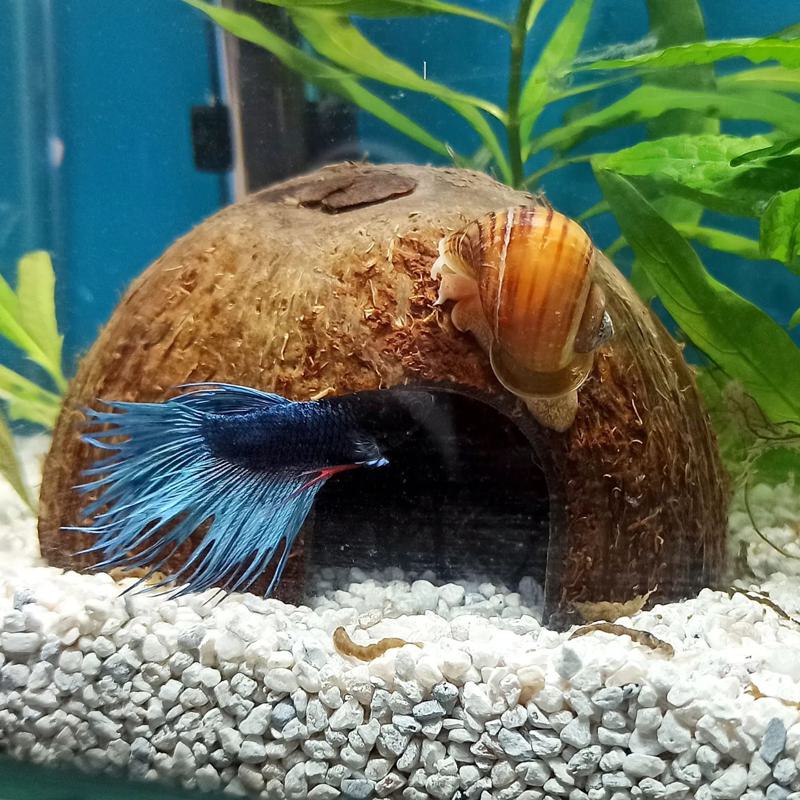
Adding snails to your betta aquarium isn’t just an aesthetic choice; many aquarists do it because of the benefits it provides for both species. If you want to add snails to your betta tank, you need to know what advantages it presents, which is what we’re going to discuss below.
Having a snail in a betta aquarium can bring several benefits, including:
- Cleans algae. Snails are grazers, and they love to eat algae. Snails will graze on the glass, the substrate, and even on the landscape of your aquarium for algae and organic matter. They help keep your aquarium spotless even with minimal manual cleaning.
- Improve aquarium water quality. Snails eliminate waste that contributes to the biological filtration process, helping to maintain good water quality. Things like uneaten fish food, decaying plant matter, and algae are favorite snail snacks, helping keep the water clean.
- Enhances the aesthetics of your tank. These creatures can add an interesting and attractive element to your betta tank with their intriguing behavior, unique shell patterns, and peaceful nature.
- Stimulates your betta. Snails can provide a natural stimulation for bettas, as bettas are naturally curious animals that like to interact with the world around them. They can find snails endlessly fascinating and are also often tough enough to endure the betta’s interest.
- Increasing diversity in your aquarium. Adding a snail to an aquarium can increase biodiversity, mimicking the natural habitat of your betta fish better and providing a more interesting environment for them to live in.
Introducing snails in your aquarium can present many benefits for your betta fish.
However, you should also remember that not all snail species are suitable for betta aquariums. You should still carefully think about several factors, which is what we’re going to talk about in the next section.
Proper Snail Care
Now that you know the advantages of having a snail in your betta tank, you might be tempted to go ahead and drop a couple of snails in your aquarium now.
Not so fast – you need to know the most important considerations when caring for these snails first.
Diet
Diet is one of the most important considerations when raising something in an aquarium. Because an aquarium is a closed system, you will be the sole source of food for these creatures, and it’s important to nourish them properly, or else they might suffer.
It’s important to consider the diet of the snails that you plan to put into your aquarium so that you can keep them happy and healthy.
Don’t worry, though – most aquarium snails eat algae, plant matter, decaying organic matter, and fish food. Essentially, they’ll eat whatever you put into the tank, which can be extra fish food or some bits and pieces of soft fruits and vegetables.
However, some snail species, like the assassin snail, are mainly carnivores and will usually only eat other snails.
Snail Species
There are many kinds of snails in the market, and the species of the snails will affect what you can expect from them.
Are you getting snails exclusively to clean your tank? Maybe you want snails that look nice and make a good aesthetic addition. Whatever your main purpose, you need to research the kind of snail you will add and ensure that their species fulfill that purpose.
Breeding
Snail breeding habits are important to consider for a variety of reasons.
If you want to breed your snail, you will need to fulfill their breeding requirements so that they multiply. Snail breeding can be difficult, as there can be extremely specific environmental conditions that you have to replicate before they start to breed.
On the other hand, breeding habits can be important in the opposite manner: sometimes, you might want to stop snails from breeding to control their population.
Certain types of snails, such as ramshorn snails, breed in abundance and can easily overrun your tank when left alone.
While they technically won’t do anything harmful for your tank, some aquarium owners may not like the visuals of snails crawling all over the place.
If you don’t want your tank to be overrun, you need to research the breeding habits of your specific snail so that you can prevent it from happening.
Water Parameters and Lighting
Most aquarium snails are pretty hardy and can adapt to a wide range of environments.
However, some species of snails can be vulnerable to sudden changes in conditions, so you might need to monitor your water all the time.
More than that, aquarium snails also originally come from different natural habitats – some might like specific water conditions that might align with your betta’s tank.
For example, nerite snails naturally live in brackish waters and can live in both saltwater and freshwater aquariums. However, they can be very sensitive to bright lights.
On the other hand, mystery snails can be seen in various bodies of water, such as lakes, rivers, and ponds. This means they can tolerate a wide range of freshwater parameters, as long as it’s not saltwater.
Space and Cover
Aside from water parameters, it’s also important to consider other environmental factors of your aquarium, such as space and cover.
While snails are pretty undemanding in terms of water conditions, they still add bioload to the aquarium. The general principle of having fewer snails in a smaller aquarium still applies.
More than that, snails are also shy creatures and love to have plenty of hiding places.
Providing cover is all the more important if you’re housing snails with a betta, which can hunt them for sport. Doing so enriches their living conditions while protecting them from predators.
Make sure to consider the space and cover needs of the snail you’re planning to get before putting one in your betta tank!
What Snails Can Live With Bettas?
Now that you have a pretty good grasp of the things that you need to consider to raise snails successfully with your betta, you might be raring to get snails for your betta aquarium.
In that case, you’ll love knowing about the best kinds of snails to keep with your betta fish, which we’ll talk about below.
Mystery Snail
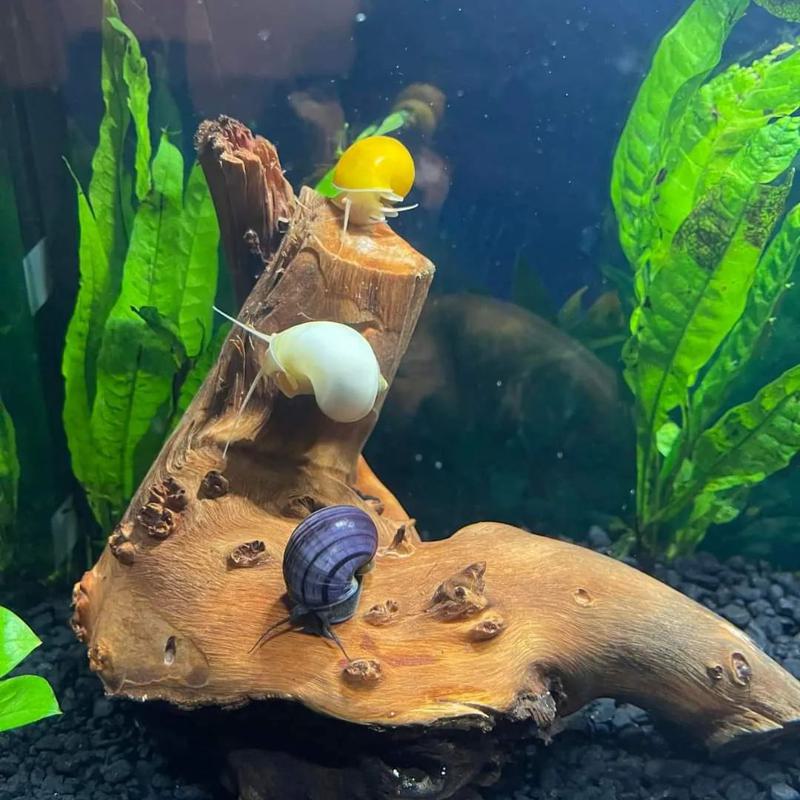
- Scientific name: Pomacea bridgesii
- Size: Up to 2 inches
- Diet: Plant and vegetation
- Color and appearance: Basic shell curve with a variety of shell coloration and patterns.
Mystery snails are some of the best betta tank mates to have around.
Its primary benefit is that it’s too big to be harmed by your betta. With their full adult size of about two inches, there’s little your betta can do to harm this fella.
Additionally, it sports attractive colorations and patterns and displays interesting behaviors.
However, they do eat plant matter voraciously. On the upside, this means they’ll religiously scour your aquarium of algae. However, it also means they may snack on your live plants if they don’t have algae to munch on, making it important to always keep this species well-fed.
Nerite Snail
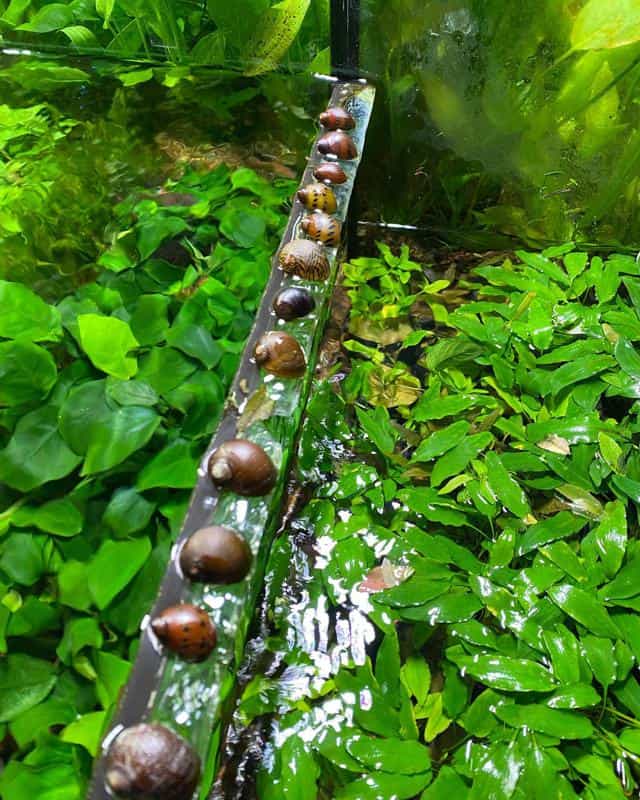
- Scientific name: Neritidae
- Size: 1 inch
- Diet: Algae and other plant matter
- Color and appearance: Wide varieties of patterns and colors
Nerite snails are a crowd favorite when it comes to betta tank mates. They’re pretty small and unassuming, so they’re not as much of a shock as mystery snails tend to be.
Moreover, they also sport many different colors, patterns, and shell shapes, so there is plenty that you can choose from when deciding on their looks.
Since they’re not as big as mystery snails, they’re also not as voracious eaters. They’re content with grazing for algae and won’t touch your plants until they’re starving. As such, they’re pretty good algae eaters without the drawbacks.
However, they might be more vulnerable to betta attacks, especially if you get them very small.
Malaysian Trumpet Snail

- Scientific name: Melanoides tuberculata
- Size: 1 inch
- Diet: Omnivore
- Color and appearance: Mostly black or brown, with trumpet-shaped shells.
When it comes to aquarium snails, opinions are varied on Malaysian trumpet snails.
On one hand, they’re great algae eaters, will tolerate a wide variety of tank parameters, and are small and generally unobtrusive. They can also provide a quick snack for bettas since their young can be small and soft enough to be hunted.
However, these types of snails can multiply rapidly. Even a single MTS can reproduce without the need for another one, and can quickly expand into hundreds of individual snails.
While they’re very small, they still do excrete waste, and enough of them can overload your filtration system and alter your aquarium parameters.
If you’re confident that you can control their population, this species is a hardy little worker that can keep your betta company.
Ramshorn Snail
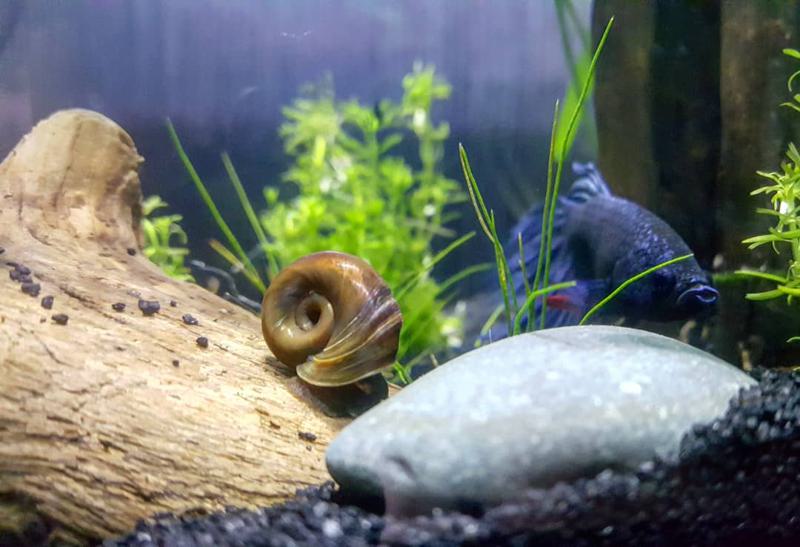
- Scientific name: Planorbidae
- Size: Up to 2 inches
- Diet: Omnivore
- Color and appearance: Light or dark brown shell with a ram’s horn shape
While they might have a charming appearance and a hardy nature, they suffer from the same potential issues as the Malaysian trumpet snails – they breed too fast. They can quickly overrun your betta tank if you don’t have any means to control your population.
Additionally, they may not be the best tank mate for aggressive Bettas. Baby Ramshorns are extremely small, and your Betta fish may try to eat them.
It’s best to stick with some of the larger, more mature snails if you’re going to keep them with your Betta fish.
However, they do keep your betta tank spotless, and they can also provide a source of nutrition for your fish.
Assassin Snail
- Scientific name: Nassariidae
- Size:25 inches
- Diet: Carnivore
- Color and appearance: Yellow and brown pattern
Assassin snails are a very interesting snail species in the aquarium hobby. True to its name, assassin snails eat other snails, making them an ideal way to control fast-breeding populations such as ram’s horn snails or Malaysian trumpet snails.
They also have a pretty unique appearance, with a striking yellow-and-brown pattern on the back of their shell that can add to the aesthetics of your tank.
Assassin snails are easy to care for, can tolerate betta attacks, and will not harm your betta.
Perhaps the only downside in keeping this snail is that it might die if you run out of pest snails in your aquarium. Since it’s purely carnivore, it will eat other snails to extinction, and you might need to add more snails to keep assassin snails alive.
Also Read:
Snails And Bettas: FAQs
What Kind of Snail Is Best for A Betta Tank?
There are many types of aquarium snails that you can house in a betta tank, but mystery snails and nerite snails work best. These types of snails do not breed fast, have no specific dietary needs, and are fun to look at.
Can Snails and Bettas Coexist Peacefully?
Bettas are natural hunters, so they’ll most likely attempt to hunt and eat the snails in your tank. If the snails aren’t too small, they’ll survive, and the betta will leave them eventually.
How Many Snails Can I Keep in A Betta Tank?
How many snails you can keep in the tank depends on the kind of snail that you plan to keep, so make sure to do your research beforehand.
Betta tanks tend to be 5 to 10 gallons in volume, and since mystery snails need about 5 gallons per individual, you can fit 1 or 2, respectively.
Keeping Snails In Your Betta Tank
Snails are some of the best tank mates that you can keep in your betta tank. they’re peaceful and interesting and provide plenty of benefits for your fishy friend.
As long as you’ve considered the points we brought up in this article, you should already be able to make well-informed decisions!
